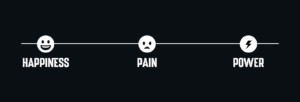How do you become good at something?
How do you master a skill?
If you pay attention, you’ll notice that the formula to master anything is the same for every individual.
There are two stages to master something:
1- Know & Understand All About That Thing
2- Put What You Know To Action.
There’s no shortcut or hack for this.
Every individual has to take the same approach to master something and become a GURU.
Now in this post, I’ll help you get closer to becoming a Facebook Advertising Guru.
As a Funnel Hacker, you need this skill in your arsenal.
Why? Because Facebook advertising is one of the most common platforms thought leaders use to drive traffic to their sales funnels.
And you need to manage, optimize, scale these advertising campaigns for better profitability.
To effectively achieve that, you need to understand every nook and cranny of Facebook advertising, and most importantly, its terminology.
This blog post will share the 31 essential key terms you should know to create profitable advertising campaigns.
That Guilty Feeling
Are you guilty of running non-profitable facebooks ads?
Are your advertising campaigns based on random assumptions and intuitions?
Can you understand campaign data to optimize your campaign for a better result?
Are you scared to tell the client that you’d need to spend some money initially to gather data and run better campaigns?
As a Funnel hacker, we are bound to feel guilty about spending our client’s money and failing to deliver results.
But, wait! Before you drown yourself in the guilt.
Think of this, and you need to create multiple ads to figure out a winner. Unfortunately, there’s no proven recipe for creating a winning ad in just one attempt.
All funnel hackers start with well-thought audience segments to create their ads. Later they change their approach and audience based on the data they have received for more profit.
So, stop feeling guilty about it.
Explain the whole process to the client, and you will be able to create better advertising campaigns with more freedom in your hand.
Remember, there’s no proven formula to create profitable ads in just one attempt.
You get the winner from multiple rounds of testings and tweaks.
And these 31 Facebook Advertising Key terms will help you understand your ads better so that you can pick the winner more effectively.
Let’s get started with the list of most effective Facebook advertising key terms.
The Facebook Pixel:
You can call this brain of your Facebook advertising.
A Facebook pixel is a small piece of code that you need to install on your website to collect all the important metrics, data that’s used to create highly targeted audiences, retargeting, and optimize the behavior of audiences.
Creating a highly profitable ad without Facebook Pixel installed is going to be a tough task.
If you have an eCommerce website, then the Facebook pixel will be the lifeblood of your whole advertising campaign.
The Facebook Business Manager:
Facebook decided to put everything under one roof and call it Business Manager. So you can access your ad accounts, pages, audiences, everything else under one roof.
One of the biggest advantages of using a business manager is that you can easily assign people, agencies to your ad accounts, pixel data, and pages.
The Ad Account:
Facebook ad account doesn’t need much of an introduction because you are already familiar with the ad account and its usage if you are reading this.
Facebook ad account is where you make money by creating your ads and storing all the ad-related information.

Facebook Advertising Keyterms That Impacts Your Profitability
When a user clicks on an ad, they are taken to the destination site, and Facebook tracks their actions, behaviors to determine the effectiveness of the ad.
But to understand the effectiveness of a Facebook ad, we need to understand the data, the key statistics being collected by Facebook.
The most intelligent advertising decisions are always made with the help of Data.
Link Clicks:
The total number of clicks on a specific ad led users to the destination site on Facebook or off Facebook.
In simple terms, when a user clicks on your ad and visits your landing page inside or outside Facebook. It includes pretty much all the clicks done by a user.
Outbound Link Clicks:
The number of clicks that take a user off of Facebook-owned properties.
Outbound clicks help you measure the amount of traffic that your ad can drive.
Unique Outbound Link Clicks:
The number of clicks that take a user off of Facebook-owned properties.
Outbound clicks help you measure the amount of traffic that your ad can drive.
Click-Through Rate (CTR):
The percentage of times people saw your ad and clicked on the link. It includes all types of clicks.
Unique Click Through Rate (UCTR):
The percentage of people who saw your ad and clicked on the link.
Outbound Click Through Rate (OCTR):
The percentage of times people saw your ad and clicked that took them off of Facebook-owned properties.
Unique Outbound Click Through Rate (UOCTR):
The percentage of people who saw your ad and clicked that took them off of Facebook-owned properties.
Cost Per Click (CPC):
The average cost for each link clicks that your ad receives.
Cost Per Unique Link Click:
The average cost for each unique click that your ad receives.
Cost Per Thousand Impression (CPM):
The average cost for 1000 impressions that your ad receives.
Cost Per Thousand Impression (CPM):
The average cost for 1000 impressions that your ad receives.
Destination Link:
The landing page, url you are trying to market through Facebook advertising.
In simple terms, the url where you want Facebook to send all the traffic.
Landing Page View:
The number of times that a person clicked on the ad link and successfully visited the destination website or landing page.
You need to have a Facebook pixel installed on your website or landing page to track these metrics.
Unique Landing Page View (ULPV):
The number of people who successfully visited your landing page.
Cost Per Landing Page View (CLPV):
The average cost for each landing page view.
Unique Cost Per Landing Page View (UCLPV):
The average cost for each unique person who has viewed the landing page.
Add To Cart:
The number of add to carts generated by your ad.
Unique Add To Cart:
The estimated number of people who added items to their cart.
Cost Per Add To Cart:
The estimated average cost you get charged by Facebook for each add-to-cart event.
Cost Per Unique Add To Cart:
The estimated average cost of each unique add to cart.
Checkout Initiated:
The number of checkouts initiated by your ad.
Unique Checkout Initiated:
The estimated number of people who initiated checkouts.
Cost Per Checkout Initiated:
The average cost for each initiated checkout through your ad.
Cost Per Unique Checkout Initiate:
The estimated average cost for each unique checkout initiated.
Return On Your AD Spend (ROAS):
The money you received derived from your ad spendings.
Purchases:
The total number of purchases generated by your ad.
Unique Purchases:
The Total number of people who completed at least one purchase.
Purchase Conversion Value:
The profit made from facebook ad generated purchases.
Common Business KeyTerms That You Should Know
You need to understand a few important terms of your business to use the Facebook advertising platform more effectively.
Average Order Value (AOV):
The average amount you spend to generate a single purchase.
Lifetime Value (LTV):
The estimated revenue you can make from a customer throughout their lifespan as a customer.
Cost Per Aquisition (CPA):
The amount you spend to acquire one customer.
The Untold Benefit:
The untold benefit of data collection is to improve the overall ad experience and profitability.
There’s only one way to serve relevant and better ads to your target audience, and that’s by comprehending the data you have about your audience and advertising.
The advertising data provides you with a deeper understanding of your audience and their behavior so that you can customize your marketing strategies to establish a strong connection to sell your products or services.
But to do all that, you need to comprehend the collected data, which is only feasible when you are aware of all the technical, analytical jargon.
What analytical term do you find hard to understand? Could you share it with me in the comments?






